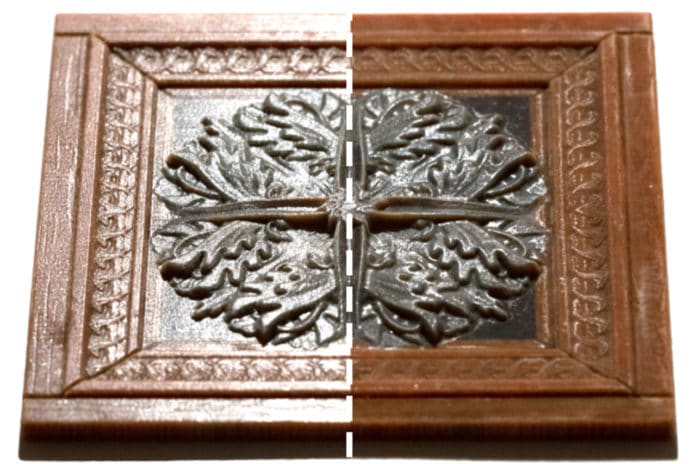3D printing technology is a powerful tool for manufacturing complex shapes with high-quality textures. Next to color and shape, Gloss is one of the most salient visual aspects of an object.
MIT scientists may have a solution. They have developed a combined hardware and software printing system that uses off-the-shelf varnishes to finish objects with realistic, spatially varying gloss patterns.
The technology has a wide range of applications: to reproduce fine art, allowing near-flawless replicas to be distributed to museums without access to originals. Also, it could be useful in creating more realistic-looking prosthetics.
Glossiness refers to the shininess and apparent smoothness of a surface. A low gloss, or matte, the surface is unreflective, like concrete.
Varnishes that lend a glossy finish tend to be less viscous and to dry into a smooth surface. Varnishes that lend a matte finish are more viscous — closer to honey than water. They contain large polymers that, when dried, protrude randomly from the surface and absorb light.
MIT researcher Michael Foshey said, “You have a bunch of these particles popping out of the surface, which gives you that roughness.”
“But those polymers pose a dilemma for 3D printers, whose skinny fluid channels and nozzles aren’t built for honey. They’re tiny, and they can get clogged easily.”
Reproducing a surface with spatially varying Gloss is labor-intensive. At first, scientists printed the object with high Gloss and support structures covering the spots where a matte finish is ultimately desired. Then the support material is removed to lend roughness to the final surface.
Foshey said, “There’s no way of instructing the printer to produce a matte finish in one area or a glossy finish in another. So, we devised one.”
The printer was designed with large nozzles. It can deposit varnish droplets of varying sizes. The varnish is stored in the printer’s pressurized reservoir, and a needle valve opens and closes to release varnish droplets onto the printing surface. A variety of droplet sizes is achieved by controlling factors like the reservoir pressure and the needle valve’s speed. The more varnish released, the larger the droplet deposited. The same goes for the rate of the droplet’s release.
Foshey said, “The faster it goes, the more it spreads out once it impacts the surface. So we essentially vary all these parameters to get the droplet size we want.”
As expected, the printer achieved spatially varying Gloss through halftoning. In this strategy, discrete varnish droplets are arranged in examples that seem like a continuous surface when seen in a good way.
Foshey said, “Our eyes do the mixing itself.”
“The printer uses just three off-the-shelf varnishes — one glossy, one matte, and one in between. By incorporating these varnishes into its preprogrammed halftoning pattern, the printer can yield continuous, spatially varying shades of glossiness across the printing surface.”
Along with the hardware, Foshey’s team produced a software pipeline to control the printer’s output. First, the user indicates their desired gloss pattern on the surface to be printed. Next, the printer runs a calibration, trying various halftoning patterns of the three supplied varnishes. Based on those calibration patterns’ reflectance, the printer determines the proper halftoning pattern to use on the final print job to achieve the best possible reproduction.
Scientists demonstrated their results on various “2.5D” objects — mostly-flat printouts with textures that varied by half a centimeter in height.
Foshey said, “They were impressive. They have more of a feel of what you’re trying to reproduce.”
Scientists are now planning to continue developing the hardware for use on fully-3D objects.
Journal Reference:
- Michal Piovarči et al. Towards Spatially Varying Gloss Reproduction for 3D Printing. DOI: 10.1145/3414685.3417850
